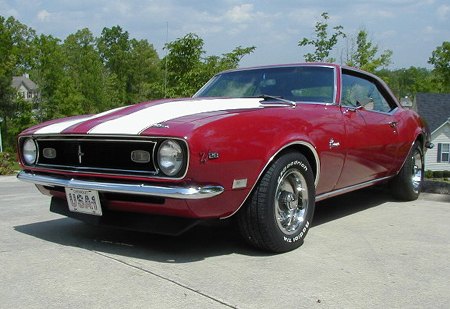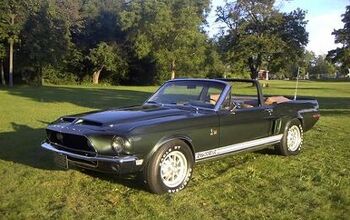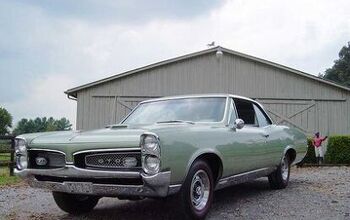The Truth About Muscle Cars: Third Place
In an act of enormous generosity, a fresh-from-the-farm fraternity pledge offered to drive the Polo-clad seniors around in his car—a restored 1967 GTO with Centerline wheels. "No one in Independence (Missouri) ever beat it," he proudly declared. "Worth over 20 grand." That was in 1990. The older fraternity brothers winced. "We'll be seen in that?" Showing maturity beyond his years, he stabled the Goat and returned next semester with a beat-up Tercel. This was, ironically, the more socially acceptable choice at my upper-middle-class fraternity.
Muscle cars are cool. They're tough. They're American. But they're not for up-and-comers. Refined? Well, no. Sophisticated? Hardly. A technological tour de force? Save them words for androgynous Europeans with little glasses. If you're the type who understands opera or worries about the safety of dolphins or includes "tofu" on your grocery list, don't even try to understand.
It's about manliness. Old-fashioned, redneck manliness. The innate masculine desire to shove rivals into the dirt and to impress women by laying a really long tire mark. A muscle car must growl and purr and warm the soul of a man raised on the Wal-Mart snack aisle. Like a WWF wrestler, skill or finesse is not necessary. Cleanliness is nice, but far from essential. Attitude is. Some fat is okay, too. In fact, lean and trim is for fairies. Men have guts, and so should their cars. Make it cheap, make it fast, and give it girth. Oh yeah, and build it in America. Otherwise, don't bother.
Because, you see, the muscle car is "real" America. Not like the fabricated John Kerrys or Paris Hiltons on TV. We're talking about the people who live in that great big area between the coasts. The Bo and Luke Dukes and their chicks who live in small towns, work in menial occupations, and drive bad ass Chargers and Mustangs. Don't ask them to understand the driver-machine ethos behind BMW. I mean, the M3 has only 6 cylinders like, you know, a girl's car. No, the real America still wears mullets, eats pork rinds, and sacrifices retirement savings for V8 engines.
What is a muscle car? The definition is terribly simple, yet inexplicably easy for manufacturers to screw up. It is:
• Big engine. V8 ideal, more is tolerated.
• Rear wheel drive. Non-negotiable.
• Made in USA. Also non-negotiable.
• Badass physique. Make it mean.
• Cheap. Must be in reach of the Best Buy salesman. Halos like the Vette and Viper are for aging orthodontists. But a $1000 beat-to-shit Firebird is accessible and totally bitchen.
Ironically, Big 3 automakers continually deviate from this definition, shaming themselves and squeezing blood from the faithful. Like the jelly-bean Aussie GTO, the stupid-high-priced Chevy SSR (would have been genius if sold for $25K), or the front-drive poser Monte Carlo. On the other hand, Grandma's 1970 Nova with coffee-can exhaust and fatter-than-Oprah tires on the back, now that's a muscle car.
Who buys 'em? Chances are, it ain't your mayor and it ain't your doctor. In fact, if you graduated from an accredited university, you're not allowed to own a Camaro. But, if you're 19 and think it's appropriate to spend 50% of your take-home pay on such a car, you may be in. Or, if you're over 40 and honestly believe life was better at 19, then you, too, may be a candidate.
The truth about muscle cars is that they're embarrassing to the intellectual elite, they indicate a lack of upward mobility, and they eschew logic and finesse over simple brute force. Driven with pride during adolescence, the maturing driver eventually sells out to more sophisticated, and typically foreign, rides. It's a phenomenon admonished by the not-so-quiet majority who appreciate bold braggadocio far more than understated elegance. But, like it or not, muscle is a part of the American identity. And the automakers that whole-heartedly embrace this identity can profit from it. The new GT Mustang and upcoming Dodge Challenger are proof of that. "Innovative" and "advanced" are not the primary descriptors of these cars. But they are profound symbols that someone in Detroit does, in fact, "get it."
While muscle cars are part of our culture, they are not all of it. In this great country anyone can, if desired, put down the spit can and make efforts to advance. The fraternity pledge who hid his GTO is proof of that. Today, fifteen years later, he drives a Volvo C70, hob-nobs at country clubs, and sells nuclear parts to the government for ungodly commissions. He still dreams of the Goat, but to him it's a pleasant reminder of an earlier phase of life now long gone. And in his place, somewhere on another college campus, a young redneck-turned-freshman is scratching his head wondering, why don't these college boys like my car?
[Published as originally submitted.]
More by Admin
Latest Car Reviews
Read moreLatest Product Reviews
Read moreRecent Comments
- Honda1 Unions were needed back in the early days, not needed know. There are plenty of rules and regulations and government agencies that keep companies in line. It's just a money grad and nothing more. Fain is a punk!
- 1995 SC If the necessary number of employees vote to unionize then yes, they should be unionized. That's how it works.
- Sobhuza Trooper That Dave Thomas fella sounds like the kind of twit who is oh-so-quick to tell us how easy and fun the bus is for any and all of your personal transportation needs. The time to get to and from the bus stop is never a concern. The time waiting for the bus is never a concern. The time waiting for a connection (if there is one) is never a concern. The weather is never a concern. Whatever you might be carrying or intend to purchase is never a concern. Nope, Boo Cars! Yeah Buses! Buses rule!Needless to say, these twits don't actual take the damn bus.
- MaintenanceCosts Nobody here seems to acknowledge that there are multiple use cases for cars.Some people spend all their time driving all over the country and need every mile and minute of time savings. ICE cars are better for them right now.Some people only drive locally and fly when they travel. For them, there's probably a range number that works, and they don't really need more. For the uses for which we use our EV, that would be around 150 miles. The other thing about a low range requirement is it can make 120V charging viable. If you don't drive more than an average of about 40 miles/day, you can probably get enough electrons through a wall outlet. We spent over two years charging our Bolt only through 120V, while our house was getting rebuilt, and never had an issue.Those are extremes. There are all sorts of use cases in between, which probably represent the majority of drivers. For some users, what's needed is more range. But I think for most users, what's needed is better charging. Retrofit apartment garages like Tim's with 240V outlets at every spot. Install more L3 chargers in supermarket parking lots and alongside gas stations. Make chargers that work like Tesla Superchargers as ubiquitous as gas stations, and EV charging will not be an issue for most users.
- MaintenanceCosts I don't have an opinion on whether any one plant unionizing is the right answer, but the employees sure need to have the right to organize. Unions or the credible threat of unionization are the only thing, history has proven, that can keep employers honest. Without it, we've seen over and over, the employers have complete power over the workers and feel free to exploit the workers however they see fit. (And don't tell me "oh, the workers can just leave" - in an oligopolistic industry, working conditions quickly converge, and there's not another employer right around the corner.)































Comments
Join the conversation